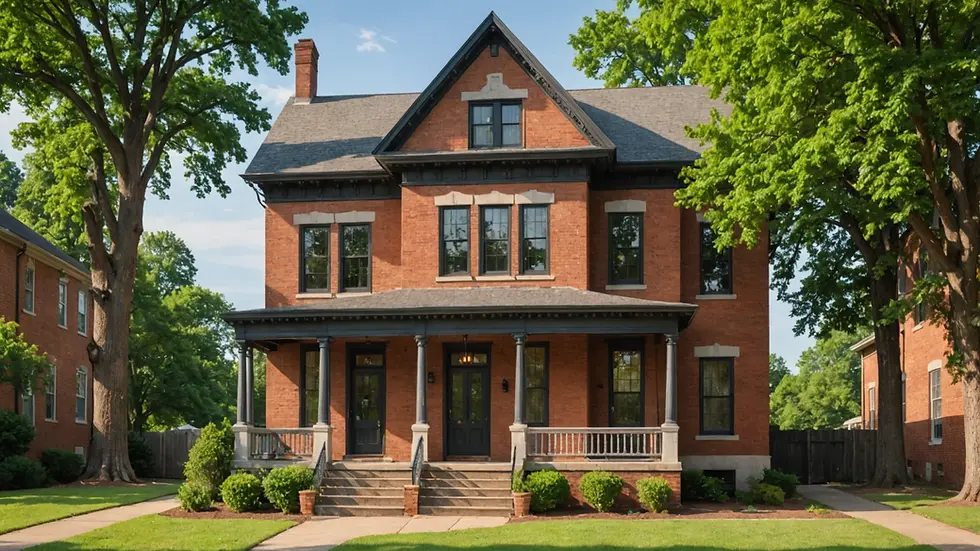Exploring the Revival: Birmingham's Historic Neighborhoods in the New Real Estate Landscape
- Wholesale Birmingham Team

- Dec 13, 2024
- 3 min read
Birmingham's historic neighborhoods are making a comeback after years of decline. Once struggling due to economic challenges and urban changes, these vibrant areas are now catching the eye of homebuyers, investors, and city planners. This post explores the reasons behind this revival and its significance for communities and investors looking to the future.
A Rich Tapestry of History
Birmingham is home to a diverse array of historic neighborhoods, rich with stories and unique architectural styles. Areas like Five Points South, Avondale, and Woodlawn feature beautifully restored Victorian houses and charming Arts and Crafts bungalows. For many buyers, living in these historic homes connects them to the city’s past.
Developers are now recognizing the potential of these older properties. Renovations that blend modern conveniences with traditional aesthetics have started to reshape these neighborhoods. For instance, a recent project in Avondale transformed two historic buildings into boutique shops and restaurants, drawing visitors and residents alike. Such initiatives not only preserve the historical character but also boost local economies by attracting foot traffic.
A Shift in Buyer Preferences
There has been a significant shift in what homebuyers are looking for. Many today prefer unique homes that reflect character and history rather than standardized suburban models. According to a recent survey, nearly 70% of millennials prefer to live in walkable neighborhoods with rich cultural attributes.
Historic neighborhoods in Birmingham are strategically located near urban amenities, making them attractive to young professionals. With a resurgence in local dining and cultural events, buyers can enjoy a lively lifestyle. Places like Avondale are known for their popular breweries and art scenes, enhancing the neighborhoods' appeal.
Investment Opportunities and Challenges
Real estate investors are increasingly eyeing Birmingham's historic areas for their potential returns. The combination of low property prices—often 20% less than the average for newer neighborhoods—and rising demand means these locations are becoming investment hot spots. For example, properties in Woodlawn have seen a value increase of around 15% over the last year, making them attractive for both long-term rental income and resale.
However, investing in historic homes isn't without its hurdles. Renovations may cost more than building new homes due to stricter preservation rules. For instance, a restoration project might average $100,000 for compliance with local standards. Yet, for those willing to tackle these challenges, the potential for profit is high, especially as buyer interest grows.
Balancing modernization and preservation will be vital. Investors must enhance these neighborhoods without losing their distinctive charm, maintaining their appeal for future residents.
Community Engagement and Revitalization Efforts
Community involvement is at the heart of the revival in Birmingham's historic neighborhoods. Local residents and organizations work together to tackle issues and create initiatives that drive improvement. Events like neighborhood clean-up days and local arts festivals not only build community spirit but also make these areas more attractive to prospective buyers.
Sustainability efforts are also gaining traction. The integration of green spaces and eco-friendly practices is appealing to environmentally conscious buyers. An example is the Renfroe Park project, which introduced walking paths and native landscaping, enhancing the neighborhood’s appeal. This collective focus on preservation and improvement fosters a vibrant community that resonates with current and future residents.

The Role of Urban Planning
Urban planning is essential for the revival of Birmingham's historic neighborhoods. Local governments are embracing plans that prioritize both historic preservation and modern development methods. New zoning laws encourage building renovations while ensuring the style fits the community's character.
Transportation enhancements, including improved public transit and additional bike lanes, have also begun to take shape. These initiatives not only make neighborhoods more accessible but also highlight their historic charm. Improved walkability and connectivity make these areas attractive to residents and businesses, setting the stage for more investment opportunities.
Forward-Looking Opportunities in Community Revitalization
Birmingham’s historic neighborhoods are experiencing a vibrant revival fueled by cultural appreciation, changing buyer demographics, and active community engagement. As these areas flourish, they present exciting opportunities for homebuyers and investors interested in the blend of history and modern living.
The ongoing development and revitalization of these neighborhoods not only enhance local communities but also shape Birmingham’s identity. For anyone looking to navigate this evolving real estate landscape, getting involved with local preservation groups and attending community meetings can provide valuable insights and connections. This engagement will help ensure a sustainable future for Birmingham's historic neighborhoods while honoring their past.



Comments